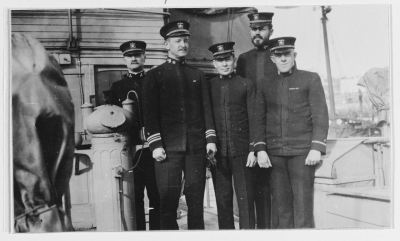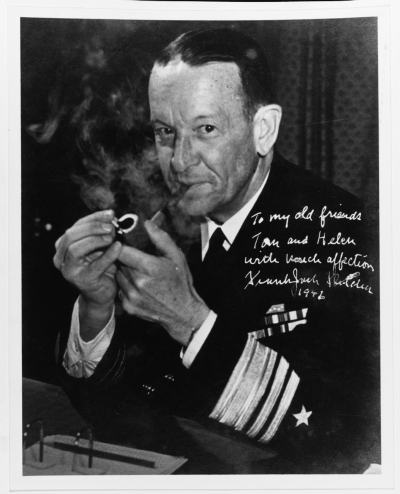Adapted from "Admiral Frank Jack Fletcher, USN, Retired" [biography, dated 15 February 1962] in Modern Officer Biographies Collection, Naval History and Heritage Command Archives, Washington Navy Yard.
- Expand navigation for Bios - A Bios - A
- Expand navigation for Anderson, Edwin Anderson, Edwin
- Expand navigation for Armstrong, Neil Alden Armstrong, Neil Alden
- Expand navigation for Bios - B Bios - B
- Expand navigation for Bean, Alan Bean, Alan
- Belknap, Reginald R.
- Bennion, Mervyn S.
- Benson, William S.
- Expand navigation for Bernatitus, Anne Agnes Bernatitus, Anne Agnes
- Boorda, Jeremy M.
- Expand navigation for Bush, George H. W. Bush, George H. W.
- Expand navigation for Bios - C Bios - C
- Expand navigation for Carpenter, Malcolm Carpenter, Malcolm
- Carter, James Earl
- Expand navigation for Cernan, Eugene Cernan, Eugene
- Expand navigation for Chaffee, Roger Chaffee, Roger
- Expand navigation for Clark, George R. Clark, George R.
- Clark, Vernon
- Expand navigation for Conrad, Charles "Pete," Jr. Conrad, Charles "Pete," Jr.
- Expand navigation for Coontz, Robert E. Coontz, Robert E.
- Cromwell, John P.
- Crowe, William James
- Expand navigation for Bios - D Bios - D
- Expand navigation for Bios - E Bios - E
- Expand navigation for Evans, Ronald Ellwin Evans, Ronald Ellwin
- Expand navigation for Bios - F Bios - F
- Fairbanks, James D.
- Expand navigation for Fechteler, Augustus F. Fechteler, Augustus F.
- Felt, Harry D.
- Expand navigation for Fletcher, Frank F. Fletcher, Frank F.
- Expand navigation for Fletcher, Frank J. Fletcher, Frank J.
- Friedell, Wilhelm L.
- Expand navigation for Bios - G Bios - G
- Expand navigation for Gleaves, Albert Gleaves, Albert
- Expand navigation for Glennon, James Glennon, James
- Expand navigation for Gordon, Richard Francis, Jr. Gordon, Richard Francis, Jr.
- Expand navigation for Grant, Albert Weston Grant, Albert Weston
- Gravely, Samuel L.
- Greenert, Jonathan W.
- Expand navigation for Griffin, Robert S. Griffin, Robert S.
- Expand navigation for Bios - H Bios - H
- Expand navigation for Hancock, Joy Bright Hancock, Joy Bright
- Expand navigation for Hasson, Esther V. Hasson, Esther V.
- Hayward, Thomas B.
- Hendrix, Henry J.
- Expand navigation for Higbee, Lenah Sutcliffe Higbee, Lenah Sutcliffe
- Holloway, James L.
- Expand navigation for Hoogewerff, John Adrian Hoogewerff, John Adrian
- Hopper, Grace Murray
- Hughes, Charles F.
- Bios - I
- Expand navigation for Bios - J Bios - J
- Johnson, Jay L.
- Expand navigation for Johnson, Lyndon Baines Johnson, Lyndon Baines
- Expand navigation for Bios - K Bios - K
- Kelso, Frank B.
- Expand navigation for Kennedy, John F. Kennedy, John F.
- Expand navigation for King, Ernest J. King, Ernest J.
- Knox, William Frank
- Expand navigation for Bios - L Bios - L
- Expand navigation for Leahy, William D. Leahy, William D.
- Expand navigation for Lovell, James Arthur, Jr. Lovell, James Arthur, Jr.
- Expand navigation for Lyle, Alexander Gordon Lyle, Alexander Gordon
- Expand navigation for Bios - M Bios - M
- Expand navigation for Mattingly, Thomas Kenneth, II Mattingly, Thomas Kenneth, II
- Expand navigation for Mayo, Henry Thomas Mayo, Henry Thomas
- Expand navigation for McCandless, Bruce, II McCandless, Bruce, II
- McDonald, David L.
- Expand navigation for McVay, Charles Jr. McVay, Charles Jr.
- Expand navigation for McVay, Charles B. III McVay, Charles B. III
- Miller, Doris
- Expand navigation for Mitchell, Edgar Mitchell, Edgar
- Morison, Samuel Eliot
- Mullen, Michael G.
- Expand navigation for Bios - N Bios - N
- Expand navigation for Niblack, Albert Niblack, Albert
- Nimitz, Chester William
- Nixon, Richard M.
- Bios - O
- Expand navigation for Bios - P Bios - P
- Bios - Q
- Expand navigation for Bios - R Bios - R
- Richardson, John M.
- Rodgers, Thomas
- Expand navigation for Rodman, Hugh Rodman, Hugh
- Roughead, Gary
- Expand navigation for Bios - S Bios - S
- Expand navigation for Schirra, Walter Marty, Jr. Schirra, Walter Marty, Jr.
- Expand navigation for Shepard, Alan Bartlett, Jr. Shepard, Alan Bartlett, Jr.
- Sherman, Forrest P.
- Expand navigation for Sims, William S. Sims, William S.
- Standley, William H.
- Stark, Harold R.
- Expand navigation for Bios - T Bios - T
- Bios - U
- Bios - V
- Expand navigation for Bios - W Bios - W
- Bios - X
- Expand navigation for Bios - Y Bios - Y
- Expand navigation for Young, John Watts Young, John Watts
- Bios - Z
- Biography
- Image (gif, jpg, tiff)
Frank Jack Fletcher
29 April 1885-25 April 1973


Frank Fletcher commanded U.S. Naval Task Forces during the key WWII battles of Coral Sea (4-8 May 1942), Midway (4-7 June 1942), Guadalcanal (7-9 August 1942), and the Eastern Solomons (24-25 August). This span of battles marked a tipping point of the Pacific War in which U.S. forces halted the progress of the Japanese Imperial Navy, sinking six Japanese carriers. Fletcher, U.S. Naval Academy ‘06, began his career with assignments in the Atlantic and Pacific Fleets. In April 1914, he served aboard USS Florida (Battleship No. 30) during the landings Vera Cruz. He was awarded the Congressional Medal of Honor for his actions during this operation. Fletcher commanded the USS Margaret (Scout Patrol No. 571) and USS Benham (Destroyer No. 49) during World War I. For his command of the latter, he earned a Navy Cross for conducting patrols and escorts in submarine and mine infested waters. Fletcher fitted and commanded several ships through the interwar period, served at the Washington Navy Yard, and completed courses at the Naval and Army War Colleges. He was assigned to the Office of the Chief of Naval Operations in the summer of 1933 and then had duty as Aide to Secretary of Navy Claude Swanson from November 1933-May 1936. Fletcher was commander of Cruiser Division 6 when the Japanese attacked Pearl Harbor. Two months after Pearl Harbor he commanded one of the two Task Forces participating in the Marshall-Gilbert Islands campaign. Fletcher was given leave in late August 1942 after nearly eight months of sustained combat. He was reassigned to command in the Northern Pacific and remained there for the remainder of the war. His forces were the first to penetrate the Kurile Islands and they occupied Northern Japan after the surrender. Fletcher served on the Navy’s General Board after WWII, retiring as that body’s chair in 1947. Admiral Fletcher passed on 25 April 1973 and was buried in Arlington National Cemetery.
Full Biography [Original .pdf] [Transcription]
Footnotes
- Accessibility/Section 508 |
- Employee Login |
- FOIA |
- NHHC IG |
- Privacy |
- Webmaster |
- Navy.mil |
- Navy Recruiting |
- Careers |
- USA.gov |
- USA Jobs
- No Fear Act |
- Site Map |
- This is an official U.S. Navy web site


